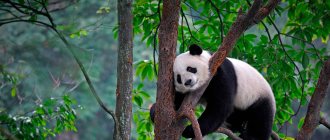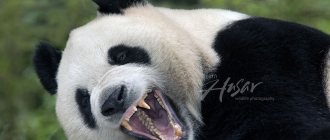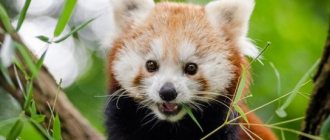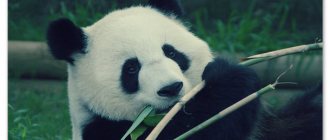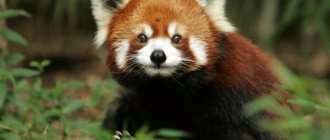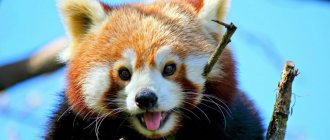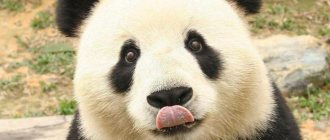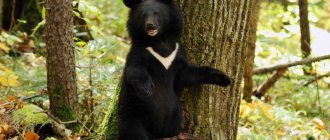There are two types of pandas in nature. The giant panda, or bamboo bear, systematically belongs to the bear family and is similar in appearance to its club-footed relatives. The small, or red, panda belongs to the panda family from the suborder Canidae. Externally, red pandas resemble raccoons.
There are not only external differences between the species: it is believed that the first red pandas appeared about 35-40 million years ago, while the fossil remains of the ancestors of bamboo pandas are 10-11 million years old. The habits and lifestyle of bamboo bears have been better studied.
Characteristics and description of the animal
Pandas lead a solitary lifestyle, creating families only during the mating season. Animals are active mainly during daylight hours. For most of the day, bears move around their territory in search of young bamboo shoots.
In the winter months, the Chinese bear sleeps a little longer than usual, but does not hibernate, which is characteristic of many members of the bear family.
Giant pandas give the impression of being slow and clumsy animals. In fact, they can climb trees quite quickly and are good swimmers. The reason for the slowness of pandas is overeating. In order to be satiated and receive the required amount of nutrients, bears must absorb a volume of food per day, the weight of which is equal to 12-15% of their own body weight.
Red pandas are active at night, and during the day they prefer to rest, climbing onto tree branches or hiding in a hollow.
Natural enemies of bamboo bears include leopards, however, due to the decrease in the number of these predators on the Asian continent, they do not have a significant impact on the population. Dwarf pandas become victims of leopards, snow leopards, and martens.
What does it look like
The appearance of giant pandas has the following features:
- the body is massive, round, relatively short;
- the paws are thick, with sharp claws, near each toe there are pads necessary for the animal to stay on the smooth bamboo trunks;
- the head is large, round with small eyes and small rounded ears;
- the tail is relatively large for a bear (length is 10-15 cm).
Most of the pandas' body is white. Only the ears, small areas around the eyes, and the front and rear limbs are black.
Red pandas have an elongated body, a large head with an elongated muzzle and pointed ears, thick paws with semi-retractable claws. The animal uses its long and fluffy tail as a rudder when moving in the trees.
The thick and long coat is colored red, brown or dark red. Along the tail there are 10-12 transverse stripes of a lighter shade. There is a mask on the face that resembles the color of a raccoon's face.
Dimensions
The average weight of an adult panda is 140-150 kg. The body length is 1.6-1.8 m. The height and weight of males is slightly greater than that of females. Usually the difference does not exceed 10-15%.
Red pandas weigh from 4 to 6 kg, while sexual dimorphism is not pronounced. The body weight of small pandas Staiana can reach 8-9 kg. The average body length ranges from 50 to 60 cm, and the tail - from 30 to 45 cm.
How many years do they live
Under natural conditions, the life expectancy of pandas is between 18-20 years. Captive animals can live much longer. So, in 2022, the death of a panda was announced, having lived to 37 years. The animal lived in one of the zoos in Fujian province in China.
Dwarf pandas live shorter lives: in nature, their life cycle usually does not exceed 10-12 years.
Behavior
Unlike many other bears, giant pandas do not hibernate. But they descend to lower altitudes during the winter. Giant pandas do not build permanent burrows, but rather take refuge in trees and caves. They are primarily terrestrial animals, but are also good climbers and swimmers. Giant pandas are mostly solitary except during breeding season. Panda mothers play with their cubs, not only to soothe the babies, but also for fun. Some mothers often wake up their cubs to play with them.
Types of pandas
For a long time, there have been discussions among scientists regarding the classification of pandas. The advent of genetic tests and molecular systematics methods has made it possible to accurately determine which family the red panda belongs to and which the giant panda belongs to.
The modern classification of pandas is as follows:
| Family | Genus | View | Subspecies | Peculiarities |
| Bearish | Giant pandas | Bamboo bear | Regular | Lives in southwest China, the animal's fur is black and white. |
| Qinlinskaya | Found in the foothills of Qinling, the dark areas of the body are colored brown | |||
| Pandas | Red pandas | Raccoon bear | Western red | Small animals that live exclusively in Nepal and Bhutan |
| Red panda Staiana | Adults are larger in size and their fur color is noticeably darker than that of the western subspecies |
A relative of the Chinese bear is the spectacled bear, which lives on the South American continent. In the raccoon, or cat, bear, the closest related species are raccoons and martens.
Getting to know Europe
The world first learned about these cute animals in 1869. David Armand, a French missionary who traveled to Mongolia, Tibet and China and collected rich zoological collections on his travels, returned to his homeland and demonstrated in Paris the skin of an unprecedented black and white bear, which was placed in the Natural History Museum. However, bringing the skin of an unknown animal to the West is one thing, but proving that it actually exists is a completely different matter. Many European scientists were convinced that such a large animal simply could not exist in nature. The unusual color of the unknown animal also raised great doubts. Many were convinced that the skin shown by Armand was the result of the work of skilled craftsmen who sewed several skins together and thus obtained this result.
But David Armand did not give up. He proved to the world that the skin he brought belonged to a real animal. He took another trip to the east and presented the skeleton of a panda to the Western world, accompanied by the story of the hunter who caught the panda.
Where does it live?
The panda's homeland is a small area in the east of the Asian continent. Currently, this part of the mainland belongs to the PRC. The habitat of giant pandas is limited to the foothills of the central part of the country.
The range of orange pandas covers much larger territories: the animal is found in northern India, Nepal, Bhutan, Burma and some provinces of China.
Where live
Giant pandas live in plains, hilly areas and foothills. The only condition is the presence of bamboo thickets. In the winter months, animals are at an altitude of up to 1000 m above sea level; with the onset of summer heat, they move up the mountain slopes, reaching 4000 m.
The natural habitat of dwarf pandas is tall forests of deciduous and coniferous trees, in the lower tiers of which a large amount of bamboo grows.
What do they eat
Chinese pandas are classified as carnivorous mammals, but most of their diet consists of plant foods. The panda eats bamboo for half the day, consuming up to 25-30 kg of green mass per day. Usually the animal chooses young and succulent parts of the plant, but if necessary, it can also eat tougher and drier stems. The bamboo bear's digestive system is fully adapted to eating and digesting tough plant foods.
When there is a shortage of bamboo, the panda feeds on the leaves of vines, vines, bark, stems and leaves of some trees. From time to time, the animal can eat bird eggs, insects and their larvae, worms, rodents and small birds.
Sluggish and plant-loving pandas are often confused with other eucalyptus-loving koala bears. In fact, bamboo and marsupial bears have significant external differences, different habitats, and also eat different foods.
Diet
Giant pandas have a strict energy reserve. They move little and, as a rule, obtain food while moving. Giant pandas can spend 10-12 hours a day eating. Bamboo is the pandas' main source of nutrition, but the animal only gets about 17% of its nutrients from the leaves and stems. Giant pandas are well known for their upright feeding posture, which allows their front legs to freely handle bamboo stalks. An extra finger on a panda's hand helps it tear bamboo. The walls of the panda's stomach are extremely muscular, thanks to which woody food is digested, and the intestines are covered with a thick layer of mucus, which protects against splinters.
Their diet consists of: bamboo stems and shoots, fruits, plants, small mammals, fish and insects.
How do they reproduce?
The slow reproduction of pandas is explained by the fact that females become ready to mate once a year and last only 1-2 days. They usually give birth once every two years, and almost half of the cubs die before reaching one year of age.
Readiness for reproduction occurs in Chinese bears at the age of 4-6 years. The signal for the beginning of the mating season is the appearance of a specific smell in females. The duration of pregnancy is about 5 months, after which one or two blind and almost bald cubs are born. If a mother bear gives birth to two cubs, she selects the most viable one and refuses to feed the second, condemning her to starvation.
The baby actively feeds and grows quickly: a newborn panda weighs a little more than 100 grams, and by 4 months it has already gained weight of 3.5-4 kg. At six months, the cubs weigh about 10 kg.
The cubs depend on their mother for quite a long time. Despite the fact that they begin to move independently at three months, the mother bear continues to feed them until they are a year old, and only after that she gradually accustoms them to solid food. Young pandas become independent at the age of about 2 years.
Bamboo bears are among those animals that do not reproduce well in captivity.
KOALA
origin of name
The first mention of the giant panda in literature occurred more than 3,000 years ago in the Book of History and the Book of Songs. In these books the animal was called pi and pixiu. The panda later appeared in the first Chinese dictionary Er Ya, the Classics of Seas and Mountains, and the Annotated Readings of the Book of Songs. In those books, the panda was referred to as mo, zhi yi and bai hu and described as a white fox, a white leopard and an animal similar to a tiger or polar bear. In later sources, the panda was again and again given new names: meng shi shou (predator), shi ti shou (iron-eating animal) and zhu xiong (bamboo bear). The origin is still controversial. Scientists cannot agree on what it is: a banded bear (huaxiong), a cat-like bear (maoxiong), a bear-like cat (xiongmao) or a great panda (daxiongmao).
It is believed that the word "panda" has a common root with the Nepalese ponya - kneecap. The authors of the hypothesis believe that such an association could arise when observing an animal at the time of their meal. Others are inclined to believe that the word "panda" was born from the Nepalese name for the red panda, wah, which comes from the loud sound that comes from the sounds periodically made by these animals. But the answer remains a mystery.
Are pandas dangerous to humans?
Bamboo bears look like large plush toys, so at first glance it may seem that these hulking hulks covered with fluffy fur are cute and good-natured animals. In fact, the panda is one of the clearest examples that appearances can be deceiving. The bear has fairly sharp teeth, with a pair of long and strong fangs on the upper and lower jaws. The animal is capable of clenching its jaws with great force, causing serious injury. An additional means of protecting and attacking a bear is its claws.
Pandas do not have a pronounced aggressive behavior, but an animal that is frightened or forced to defend itself may well attack. Since bamboo bears are a very rare species in the wild, most attacks are recorded in places where they are kept in captivity. An attack by a panda on a person can result in serious injuries, including the loss of limbs.
POLAR BEAR
Natural enemies of anteaters
Photo: Anteater
If in the wild conditions such large predators as pumas and jaguars act as enemies for giant and four-toed anteaters, then for dwarf representatives of the anteater family there are much more dangers; they can even be threatened by large birds and boa constrictors.
The large anteater's main weapon is its huge ten-centimeter claws, with which it can tear apart an enemy like sharp hook knives. During a fight, the animal stands on its hind legs and fights its enemy with its front legs; these strong limbs can even crush the enemy. Often, predators, seeing such courage and power, leave and do not contact the large anteater, because they consider it a dangerous and strong opponent, capable of inflicting serious wounds.
Tree baby anteaters also bravely defend themselves, despite their dwarf size. They also stand in a stance on their hind legs, and keep their front claws ready in front of them to strike the enemy.
The four-toed anteater, along with the main defense mechanisms, also uses a special odorous secretion, which is secreted by its anal glands, scaring away enemies with an unpleasant odor.
Why is the panda listed in the Red Book?
The population of bamboo bears has never been large. Judging by the information contained in ancient Chinese manuscripts, the animal was already considered rare at that time. In the last century, the number of pandas has declined so much that they were listed as an endangered species on the International Red Book. The catastrophic decline in the number of bears was caused by hunting of these animals and the reduction of their natural habitat.
China has taken a number of measures to preserve the critically endangered giant pandas. As a result of this, the number of the animal first stabilized and then began to gradually increase. Already in 2016, experts made a proposal to change the status of the animal on the IUCN list from an endangered species to a species in a vulnerable position.
Raccoon bears are also included in the Red Book, but their situation is not as optimistic as that of giant pandas. Currently, there are no more than 2.5 thousand individuals of this species left in the world. The main reasons why red pandas are dying out are deforestation and trapping of animals for fur and further use in folk medicine.
What does a grizzly bear eat?
Photo: Animal grizzly bear
Due to repeated attacks on people and livestock, the grizzly bear has a reputation as a cruel and merciless killer. However, this is not entirely true, and this type of predator objectively belongs to the category of omnivores. In ordinary life, when his aggressive behavior is not provoked by anything, the bear gives preference to plant foods: berries, roots, shoots and fruits of plants. In addition, these powerful animals happily feast on bird eggs, reptiles and their future offspring, frogs and insects.
For the coastal variety of grizzly bears, fish is a significant part of the daily diet. When the time comes for spawning, and the prey itself jumps out of the water, the tenacious paws of the predator with dexterity pick it up right on the fly.
As for large animals, most likely the grizzly will choose as prey an old and sick individual sika deer, ram, goat, or chamois, as well as inexperienced young animals of other forest inhabitants. According to popular belief, bears are great connoisseurs of honey. This is true, only this delicacy is available mostly to bear cubs, due to their small size and ability to climb trees.
The teeth of a gray bear have a specific shape and are intended for various types of food - both plant and animal. An adult needs to consume about 20 thousand kilocalories per day. Such an urgent need for food forces grizzlies to almost constantly be in a state of search for food, especially before hibernation.
Interesting facts about pandas
- Bamboo bears are distinguished by a special structure of their front paws: the usual five fingers are opposed to the sixth, which is a modified sesamoid bone. An additional finger makes it easier for the animal to eat bamboo, helping to hold the torn stems.
- In the entire history of China, only a few dozen cases are known when pandas were legally exported from the country as gifts to other rulers or to be kept in zoos. Currently, animals are given to zoos exclusively for rent, with the condition that if cubs appear, they will be the property of the PRC.
- The panda is listed in the Guinness Book of Records as the most attractive wild animal.
- To protect and increase the panda population in China, over the past decades, more than 50 reserves and nature reserves have been created, with a total area of more than 1 million hectares.
- The importance of pandas in nature lies in the fact that the animals carry bamboo seeds in their excrement, contributing to the spread of this plant.
Chow bears
Looking at chow chow babies, you might think that these are little bear cubs. But, in reality, they are puppies of this breed, artificially colored so that there is an external resemblance to the cubs of the famous panda. Nowadays it is considered quite a fashionable trend in China, in which fluffy Chow dogs undergo a thorough modification in the form of haircuts and coloring. This manipulation can be performed by any owner for his pet so that he looks like a furry funny bear.
The session takes approximately 2 hours, and the panda disguise lasts only 1.5 months. But the consolation is that the procedure is completely harmless for the animal.
In their natural habitat, animals have no enemies, but, nevertheless, these beautiful creatures of nature are completely unprotected from natural disasters. A huge threat to animals is the period of mass flowering of their favorite bamboo. Being a long-lived plant, it can bloom only once during its entire existence, followed by complete death. With its mass death on huge plantations, pandas are completely left without food. The only salvation for them is migration to other territories where there are areas where their favorite delicacy grows.
Although in modern China there are few natural places left where bamboo grows.
But thanks to their iconic position in the country and unimaginable popularity, pandas are protected from extinction by the investment of huge amounts of money by the Chinese government in a program of strict protection and assistance in breeding these unique animals.



